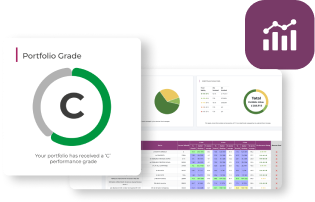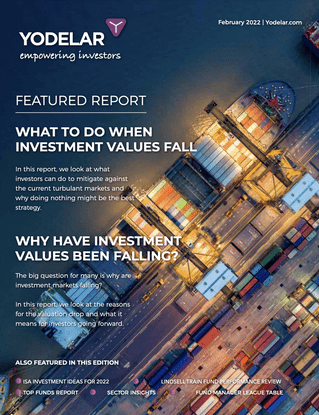-
Analysis of more than 400 investor portfolios found that many investors continue to hold the same funds year after year, even when those funds have fallen well below their sector averages.
-
This tendency reflects portfolio complacency, where comfort with familiar or long-held funds replaces evidence-based review and adjustment.
-
Across every major Investment Association sector, the performance gap between top and bottom quartile funds remains wide, showing that fund selection has a major impact on outcomes.
-
In the IA Global sector, top quartile funds achieved 102.04% growth over five years compared with just 24.65% for the weakest, demonstrating the long-term effect of holding underperforming funds.
Our analysis of more than 400 investor portfolios this year revealed a recurring pattern. Many investors continue to hold the same funds year after year, even when those funds have fallen well below their sector averages.
This behaviour is understandable. Investors often develop confidence in long-established fund names, trusted brands and well-known managers, particularly when those funds have delivered strong returns in the past. But over time, that sense of comfort can lead to complacency. Funds that once performed well can lose their competitive edge, and when investors do not review or adjust, portfolios gradually lose efficiency.
Across the portfolios analysed, this pattern of “set and forget” investing was one of the most consistent causes of underperformance. In many cases, growth fell behind because portfolios were anchored to funds that had drifted below their sector averages for several years.
Behavioural research supports this tendency. Studies have found that investors are more likely to hold underperforming assets when they feel comfortable with them, even when evidence suggests better alternatives exist (The Impact of Familiarity on Individual Investors’ Decision Making, International Journal of Financial Studies, 2021). Another study found that investors often favour investments they recognise over those they do not, showing how comfort with the known can quietly shape decision-making (Familiarity Bias Amongst Individual Investors, South African Journal of Economic and Management Sciences, 2017).
While comfort is natural, it can come at a cost. The difference between top and bottom quartile fund performance across every major sector shows that inertia — not just poor timing — is often the key reason portfolios fall behind.
Why Portfolios Fall Behind
Investors rarely intend to take unnecessary risk or limit growth potential. Yet over time, portfolios can drift simply because investors stay with what feels familiar and avoid revisiting older holdings. This inertia means that underperforming funds can remain in place for years, reducing overall portfolio efficiency.
In the IA Global sector, for example, top quartile funds achieved 102.04% growth over five years, while the weakest quartile delivered only 24.65%. In the IA UK All Companies sector, the leading funds grew by 98.86% compared with 38.05% for the lowest quartile. Such differences highlight why ongoing evaluation and selective adjustments can make a significant long-term impact.
A data-led review process helps identify when funds have fallen behind their peers and whether they continue to align with an investor’s objectives and risk profile. This approach is not about reacting to short-term performance but ensuring that each component of a portfolio continues to earn its place.
Evidence of Performance Dispersion
The scale of variation across fund sectors highlights why reviewing individual fund performance is essential. The table below shows that the gap between top and bottom quartile funds remains significant across every major Investment Association category, demonstrating how much results can vary within the same sector.

*Source: hub.yodelar.com. Figures up to 27th October 2025
Within the IA Global sector, the average fund delivered 12.56% growth over 1 year, 43.14% over 3 years, and 60.98% over 5 years. Yet top-quartile funds in this sector grew by an average of 100.86% over 5 years, while the weakest quartile achieved only 22.94%.
A similar spread appears in the IA UK All Companies sector, where top-quartile funds averaged 101.87% growth compared with 19.51% for the lowest quartile over five years. In the IA Global Emerging Markets sector, the best funds achieved 68.53% growth versus 36.12% for the weakest.
These differences demonstrate how two investors with similar sector exposure can experience vastly different outcomes based solely on the funds they select. In many of the investor portfolios reviewed, the primary driver of underperformance was not poor market timing but continued reliance on funds that had steadily fallen behind their peers.
While past performance is not a guide to future returns, sustained underperformance relative to a fund’s sector average often warrants review. Over time, even small return differentials can compound into meaningful shortfalls.
Familiarity and Behavioural Bias
Familiarity gives investors a sense of safety. Selling a fund that has been held for years can feel unnecessary, particularly if it once performed well. This emotional comfort often leads to inertia, keeping things as they are rather than reviewing whether they still work.
Psychologists call this familiarity bias, and it is one of the most common behavioural tendencies among investors. Research has repeatedly found that people are drawn to what they know. In one study, investors were around 30% more likely to invest in companies they recognised, even when unfamiliar options offered similar or better prospects (Familiarity Bias Amongst Individual Investors, South African Journal of Economic and Management Sciences, 2017). Another experiment found that participants were significantly more likely to hold onto losing positions when those investments were familiar to them (The Impact of Familiarity on Individual Investors’ Decision Making, International Journal of Financial Studies, 2021).
This bias can also reduce diversification. If several of an investor’s preferred funds share similar styles or regional exposures, their portfolio may become overly concentrated in one area. This can increase risk without intent. Independent research and guidance from advisory firms have consistently shown that over concentration in familiar assets is a common cause of long term inefficiency (Raymond James, Mind Matters: Familiarity Bias, 2023).
Why Regular Comparison Matters
The findings from the 423 portfolios analysed through Yodelar’s portfolio review service during 2025 reinforce the importance of ongoing comparison. Many investors were unaware that several of their holdings had slipped well below their sector averages. In some cases, these funds had remained in place for years simply because they were familiar names or had delivered strong results in the past.
Regular comparative analysis helps to identify these performance gaps early. By reviewing each fund’s returns relative to its sector quartile ranking, investors gain a clearer view of how efficiently their capital is allocated. It also allows for small, data-driven adjustments that can help sustain overall performance and diversification.
This process does not rely on forecasting or market timing. Instead, it focuses on evaluating how well each component of a portfolio is performing relative to peers and whether it continues to align with the investor’s objectives and risk profile.
Balancing Loyalty with Evidence
Loyalty to funds or managers is not inherently bad. In many cases, long-term commitment to a well-managed fund can be rewarding. However, loyalty must be supported by ongoing evaluation. Without it, portfolios risk becoming anchored to past success rather than positioned for future opportunity.
The most effective approach is evidence-led rather than reactive. Reviewing each fund’s performance, consistency, and underlying holdings against sector averages provides clarity on whether it remains suitable. If a fund continues to perform well relative to peers, there is reason to remain invested; if not, a review of alternatives may be warranted.
This structured discipline allows investors to maintain familiarity where it adds value — and to make objective changes when it does not.
Maintaining an Adaptive Portfolio
Markets evolve, leadership rotates, and investment styles rise and fall in and out of favour. Portfolios that adapt to these shifts while maintaining balance and diversification tend to remain more efficient over time.
An adaptive approach does not mean constant change. It means maintaining awareness — understanding how each fund contributes to overall risk, diversification, and performance, and making small, considered adjustments when needed.
By combining familiarity with evidence, investors can retain confidence in their portfolios while ensuring they continue to reflect their objectives and current market conditions.
The Value of an Independent Portfolio Analysis
Every investor’s portfolio tells a story — of past decisions, market trends and personal preferences. Yet without regular analysis, it becomes difficult to see whether that story is still moving in the right direction.
A portfolio analysis provides clarity. It identifies which funds have performed well relative to their sector and which have fallen behind, how diversified the portfolio truly is, and whether costs, duplication or drift may be limiting efficiency. Many investors are surprised to learn that a small number of underperforming funds or overlapping holdings can quietly erode overall returns.
Through the Yodelar portfolio analysis service, each holding is assessed against its sector peers over 1, 3 and 5 years. This data-led review highlights how effectively your portfolio has been performing and where changes could add value. The outcome is not advice, but insight — giving investors a clear, factual picture of how their portfolio compares to the wider market.
For investors who wish to take the next step, our team can discuss the findings in more detail and explore whether a managed solution could improve performance consistency and efficiency over time.
Conclusion
Familiarity brings comfort, but in investing, comfort can sometimes conceal inefficiency. Portfolios built around long-established funds may feel secure, yet over time, performance disparities can quietly reduce effectiveness.
The evidence shows that outcomes within each sector vary widely. Continual oversight, regular comparison, and a willingness to challenge long-held assumptions help ensure that portfolios remain efficient and aligned with their goals.
In a changing market, successful investing is not about constant reinvention — it is about remaining aware, adaptive, and guided by evidence rather than emotion.

















